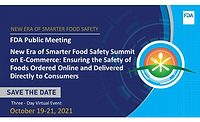Singapore Sets Standards for e-Commerce Food Safety

Credit: Norma Mortenson (norma-mortenson) via Pixabay
The Singapore Standards Council has recently released new guidelines for food e-commerce, which aims to help food business operators (FBOs) along the food e-commerce supply chain understand their respective roles and responsibilities related to food safety and providing information to consumers. The standard also guides FBOs in executing traceability, as well as on international food e-commerce.
Singapore’s regulatory framework is supported by science-based risk assessment and management measures to ensure food safety along the food supply chain. The guidelines aim to complement the current regulatory framework in Singapore. The standard provides guidance to FBOs to ensure food safety and appropriate product information for consumers, and on FBOs’ roles and responsibilities in ensuring safety and integrity of food along the food e-commerce supply chain. The guidelines also provide practical steps to be implemented at various points along the food e-commerce supply chain to achieve food safety for food e-commerce.
With regard to a cross-border e-commerce (CBEC) model, the guide covers only guidance for CBEC by individuals for personal consumption. It is presupposed that import activities pertaining to commercial food imports are in compliance with prevailing regulations in Singapore. FBOs are to check if there are any prevailing rules or regulations for bringing foods for personal use by the competent authorities.
Based upon the various types of food e-commerce channels with different operating models, including CBEC for personal consumption, the guidelines are focused on the key stages and activities that might be critical to food safety along the supply chain, as follows:
- FBO/retailer onboarding process
- At the point of e-commerce sale
- Last mile delivery
- At the point of delivery
- Traceability and product recall.
The guidelines provide better clarity for FBOs on:
- The respective roles and responsibilities of different FBOs throughout different stages of the food e-commerce chain
- The types of information to be displayed at the point of e-commerce sale and at the point of delivery
- The traceability and product recall mechanism.
The guidelines refer to a representative sample of common food e-commerce operating models throughout, and it is acknowledged that alternative operating models may be released in the future. The standard was developed by the Working Group on Food E-commerce set up by the Technical Committee on Food Processing, Distribution, and Services under the purview of the Food Standards Committee.
Looking for a reprint of this article?
From high-res PDFs to custom plaques, order your copy today!






